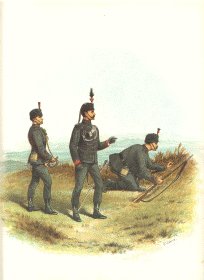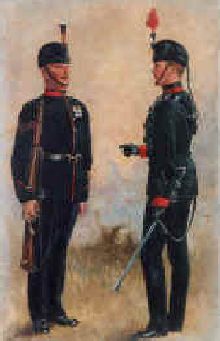Carlow Militia 1715-1908
By Breda Maher
In addition to the regular army in Ireland
during the 18th and 19th century there was also another organised
military force which, although not a permanent feature of Irish history
did play an important part in the military history of Ireland and in
fact formed the basis of today’s reserve forces - this military body was
known as the Irish Militia.
At three points of time during the 18th and
19th century Britain was to become involved in three separate wars
abroad, hence the majority of the army detachments in Ireland were often
called away to the front line. The Militia then became ready to be
called upon to maintain public order and to SUPPRESS riots or
insurrection. This duty was seen by the English Government as a
necessity in Ireland whose political opportunities were enhanced by
England’s difficulties abroad. The English Government assumed that in
times of trouble that men of the Militia regiments would remain loyal to
their officers and to the Government. Time would prove the truth of this
assumption.
Officer Ranks Were Held By Protestants
The Irish Militia when it was formed in 1715
was almost entirely composed of men of property and was restricted to
Protestants between the ages of 16 and 60. Catholics were not permitted
to join this elite regiment until an act of Parliament in 1793 which
amended the majority of the previous laws regarding the Militia made it
possible for Catholics to join the Militia.
The rank of officers in the
Militia was also made open to both Catholics and Protestants, there was
however a definite pattern throughout the 32 counties - where the ranks
of Officer was held mainly by Protestants and the majority of privates
were Roman Catholics. One aspect of the bill of 1793 which caused an
outcry in Ireland was the necessity of recruiting by ballot, the act was
further amended to replace recruiting by ballot, with voluntary
recruiting.
Regiment Formed In Carlow In 1793
The majority of the 32 counties in Ireland
started forming their Militia in the early months of 1793. Carlow was no
exception; here a regiment was formed as early as April 1793. Henry
Bruen of Oak Park was appointed as the first Colonel of the Carlow
Militia. Col. Bruens service was cut short two years later by his death
in December 1795. The Carlow Militia consisted of a Colonel, a
Lieutenant Colonel, two Majors, six Captains, 13 Lieutenants and 600
rank and file. All of the officers were Protestant except for the
Adjutant, Quarter-Master and Surgeon. There were five companies
totalling in all about 240 men in the Carlow Militia when it was first
formed.
One of the early ceremonials was the
presentation of colours to the regiment. This expensive item was more likely met by Col.
Bruen. The Carlow Militia also held its own band. Once the Militia had formed it was
imperative that training began immediately as the greater majority of
the men had no experience in regular army training and exercises.
When a
training course had been completed the general Officer reviewed the men
in marching, line formation, firing by companies, firing by wings etc.
The Dublin Evening post said of the Militia in Carlow ‘The Regiments of
the Militia here, compared with the regulars from Great Britain have the
decided superiority.’
The Militia Appeared Far More Attractive
Than The Regular Army
The Militia unlike the regular army never
experienced a shortage of volunteers offering their services. Perhaps
the reason for their large numbers of Volunteers was that service in the
Militia appeared far more attractive than service with the Regulars,
since there was no possibility of being sent overseas. Eventually since
so many recruits were using the Militia as a form of draft dodging, the
law was altered to allow men to transfer into the regulars, which for a
ten guinea bounty was offered. This law helped the recruiting problems
of Britain in Ireland since large numbers of men, fired by the exciting
accounts of events in the Peninsula rather than out of a sense of
patriotism to the English Government, were only to eager to transfer
regiments known to be going to Spain. In 1809 from a total of 112,000
new recruits in Great Britain and Ireland, over 54,000 were transfers
from the Militia.
A typical recruiting poster of the 18th century
read “Wanted - brisk lads, light and straight, and by no means gummy,
not under 5 feet 5˝ inches or over 5 feet 9 inches in height. Liberal
bounty; good uniforms; generous pay! Step lively and come in while there
is time!”
Carlow Militia Quartered in 8 Counties by
the Summer of 1798
From the beginning it was the policy of the
Militia to be quartered in towns and counties some distance from their
county of origin, because of the difficulty and consequences that could
arise from being stationed too Close to friends and relatives, which
would only make policy difficult. In 1793 the Carlow Battalion was
stationed in Nenagh and the years that followed saw it quartered in
numerous centres throughout the country. The summer of 1798 found the
Carlow regiment based in Navan, having already served in at least 8
counties. Contrary to the belief of the insurrectors of 1798 the Militia
did not abandon their leaders to aid the rebel cause. It was not a
question of their loyalty to Great Britain rather it was a willingness
to serve the officers who paid their wages. The Carlow Militia were
involved in a skirmish on the banks of the Boyne - and although there
aren’t many details of this action available it is generally believed
that the rebels fled before the Militia.
Hated By Certain Elements Of Irish
Society
Once the rebellion was over the Militia were
once again on the move and records show they were stationed for a period
in Cork, Middleton, Mullingar and Roscrea. As a result of the services
carried out by the Militia in the name of maintaining law and order it
was only natural that they would become thoroughly hated by certain
elements of Irish society. Frequently the Militia were set upon by
rebellious mobs but in many cases the Militia were more reticent about
using force on their fellow countrymen. When called to a troubled area
the Militia used their good sense in dealing with would-be
mischief-makers.
Arriving in the area the Militia would put on a show of
force marching in their full impressive uniforms throughout the town
often giving the impression to the surprised riot they were in fact a
regiment of the regular army, hence the good sense of the Militia
prevailed and there was rarely any blood shed with these potential
rioters. In March 1816 the Carlow Militia made their last long march,
this time they came back to Carlow where they were formally disembodied.
The Napoleonic Wars in Europe finally at an end the regular army was
once again stationed in Ireland; hence the Militia had become a spent
force.
The Carlow Rifles
 For forty years after 1815 external relations
between the European countries remained stable on the surface during
what became known as the ‘long peace in Europe’. This ‘peace’ eventually
bubbled over in 1854 with the start of the Crimean War. With the start
of the war the year 1854 saw the revival once again of the Militia.
Enrolment of volunteers commenced in December 1854. The Militia or the
Carlow Rifles as they were known were stationed full time in Carlow and
there are no records of their being transferred. Many of the men who
joined the Rifles later transferred to the Regular Army and did in fact
serve with the Regular forces in Crimea. The Rifles remained on
permanent duty after the war and it’s primary function was the provision
of recruits for the Regular Army. They became known in the town
affectionately or otherwise as ‘old fogies’. For forty years after 1815 external relations
between the European countries remained stable on the surface during
what became known as the ‘long peace in Europe’. This ‘peace’ eventually
bubbled over in 1854 with the start of the Crimean War. With the start
of the war the year 1854 saw the revival once again of the Militia.
Enrolment of volunteers commenced in December 1854. The Militia or the
Carlow Rifles as they were known were stationed full time in Carlow and
there are no records of their being transferred. Many of the men who
joined the Rifles later transferred to the Regular Army and did in fact
serve with the Regular forces in Crimea. The Rifles remained on
permanent duty after the war and it’s primary function was the provision
of recruits for the Regular Army. They became known in the town
affectionately or otherwise as ‘old fogies’. |
Colours laid up in 1890 in St. Mary’s
Church
The Officers and the Privates spent 27 days of
each year participating in an extensive training course and new recruits
did drill training. By 1881 the Irish Militia virtually ceased to exist
as a distinct body and it was only natural that they were united with
the line battalions to form Territorial Regiments. The Carlow Rifles
became a Militia battalion of an English Regiment as The 8th King’s
Royal Rifle Corps. They now changed their redcoats for rifle green
jackets with black buttons and scarlet facings. Their colours were laid
up in 1890 in St. Mary’s Church, Carlow. In 1887 a detachment of the
Regiment were sent to England to participate in the Royal Review for
Queen Victoria. The Regiment of the King’s Royal Corps from Carlow
distinguished themselves on this occasion by winning a tug-of-war
tournament against an English Regiment of the King’s Royal Rifle Corps.
Regiment Was Finally
Disbanded In 1908
-

- The Kings Royal Rifle Corps by
- Richard Simkin c1887-89
|
-

- King's Royal Rifle Corps in 1880 by
- Harry Payne (1858-1927)
|
In 1899 with the outbreak of the Boer War, the
Regiment was stationed in Templemore. Many of the recruits fought in the
Boer War in South Africa. In the later years of its existence it was
based in the Carlow Barracks and did it’s training either locally or at
the Curragh Camp. The Curragh. Camp was built shortly after the Crimean
War of 1854 and up until this there was no definite training centre for
recruits in Ireland. The Regiment now consisted of four companies and
its last Colonel was J.K. Milner who was a renowned shot with both the
rifle and the pistol. It is recorded that at one international contest
in England, he placed every shot in the bulls eye. The Regiment was
finally disbanded in 1908 under the Haldane scheme, which affected all
three English Regiments in Ireland, including Carlow’s 8th King’s Royal
Rifles Corps.
It is believed that some of the members of the
Carlow Militia who emigrated to the states in the early 19th century
aided in the formation of the Militia in Philadelphia, which formed the
basis of America’s National Guard.
Source:
CARLOW
Now & Then Vol. 1 - No. 3 Winter 1997/98
(Additional images inserted by M
Brennan)
NEXT PAGE
Please report any images or
links which are not working to
mjbrennan30@gmail.com
-
Please report any links or images which do not open to
mjbrennan30@gmail.com
- The
information contained in these pages is provided solely
for the purpose of sharing with
others researching their ancestors in Ireland.
- © 2001 Ireland Genealogy Projects,
IGP TM
Back to the top